Use of Moringa (Moringa Stenopetala) Seed Extract for Removal of Some Anionic Dyes (Direct and Reactive Dyes) in Textile Wastewater - Juniper Publishers
Journal of Fashion Technology- Juniper publishers
Abstract
With textile wastewater being one of the most sources of pollution containing higher value of colour, BOD, COD and several pollutants, brings serious problem to the ecological environment. This study is particularly focused on evaluating the efficacy of removal of dyes such as reactive dyes, direct dyes, mixture of dye wastes and mixture of industrial and dye wastewaters by the natural absorbent Moringa. The seeds of the Moringa tree contain a coagulant protein that can be used in the treatment of industrial wastewater. The extracts of seeds (coagulant) obtained by two methods viz. simple extraction with distilled water and with saline water have been used for the study. The effect of some operating parameters on coagulation namely pH, coagulant dosage, mixing time, colour removal and turbidity was studied. It was observed that the colour removals in direct red and reactive red dyes are 94.45 and 98.4% respectively with simple extract of seeds done with distilled water and it was in the order of 96.6 and 97.3% respectively with saline extracts of the seed. These values of colour removal of dyes are optimized at 70ml/L of coagulant and pH 10. The mixture of industrial wastewater and dye wastes, colour removal and turbidity removal was 85.8% with simple extract and 53% with saline extract respectively at optimized point. Moringa stenopetala seed has demonstrated to have high removal ability for anionic dyes.
Keywords: Moringa stenopetala; Natural coagulant;Colour removal; Wastewater; Treatment; Coagulation; Flocculation
Introduction
In textile waste water, dyes are considered the most important pollutants. High volume of waste water that is produced by the textile industry causes water pollution. Generally, dyes in waste water from textile and dyestuff industries are difficult to remove. This is because dyes are usually synthetic and have complex aromatic structures which make them more stable consequently they are difficult to biodegrade [1]. The removal of dyes from textile waste water is one of the most environmental challenge [2]. For many years, researchers have been working on ways of removing dyes from wastewater and different procedures have been developed; for example, physical and chemical degradation and adsorption onto materials such activated carbon and, in addition to a large number of other techniques such as Fenton’s oxidation, electrochemical degradation, ozonisation, etc [3]. The most commonly used in the textile industry are chemical methods that use oxidizing agents such as, peroxide of hydrogen, ozone and purification by physicochemical process of coagulation-flocculation, in which chemical compounds are used, the most employed are iron and aluminum salts [4]. This physicochemical process is widely used both in developed countries as in developing, for it easy operation and low cost. Nevertheless, when applied in textile wastewater, it generates large volumes of sewage sludge and the ineffective decoloration of some soluble dyes.
Moringa tree belongs to the family Moringaceae which is shrubs trees cultivated across the whole of the tropical belt including Ethiopia, used for a variety of purposes such as food, medicinal, and others [5]. The seeds of the Moringa tree contain a coagulant protein that can be used in the treatment of industrial wastewater. For drinking water clarification, Moringa seeds is also used as coagulant/flocculent agent due to its high content of a water-soluble cationic protein which able to reduce turbidity. Oil extracted from Moringa can be used for water treatment, for drinking water clarification and it is also used for textile wastewater treatment [6]. The use of natural coagulant is followed in developing countries, as substitution of external chemical coagulants such as aluminum sulfate and ferric chloride. The water -soluble extract of the dry seeds of Moringa is one of the natural coagulants. Moringa is used for water treatment in two different methods, one as a primary source of activated carbon and the second method through seed extraction, and produce a product working as a coagulant/flocculant agent [2].
At low temperature working conditions, the performance of these customary chemical coagulants is dubious and on-going developments have resulted in the introduction of polymerized aluminium coagulants. Owing to its higher superiority and lower consumption of alkalinity, Polyaluminium chloride (PACl) has garnered a growing market. Flocculants such as the more common polyacrylamide, which are organic synthetic polymer available in the market, offers a wider selection of chemical coagulants to cater for the diverse requirements of the individual water treatment plants [7]. Currently, there is an increased interest in the decolorization and decontamination of industrial textile wastewater. Different treatment technologies have been studied in order to solve the problems caused by the toxic substances contained in industrial textile wastewater, such as electrocoagulation, adsorption, photocatalytic process, ozonation, membrane bioreactor and anaerobic/aerobic biological treatment [8]. However, these methods are neither economically nor technologically suitable for large scale use and normally require the combination of two or three methods to achieve an appropriate level of colour removal [9-11]. The various coagulants attempted for colour removal and their efficiencies are listed in Table 1. To overcome the drawbacks of inorganic coagulants and synthetic polymers associated with growing environmental concerns worldwide, there is a need to consider other potential alternatives for textile wastewater treatment in order to minimize environmental damage and improve the wellbeing of human populations. Therefore, researchers have shown considerable interest in the development of natural polymers as coagulants in the recent past [7,12-14].
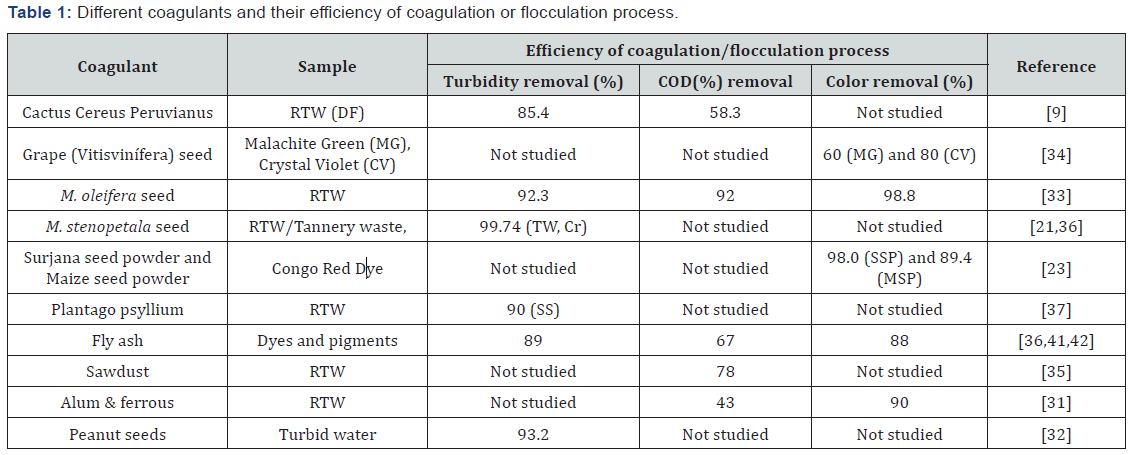
RTW: Real Textile Wastewater; SS: Suspended Solids; SSP: Surjana Seed Powder; MSP: Maize Seed Powder; TW, Cr: Tannery Waste, Chromium
Plant materials as coagulants offer several advantages over conventional coagulants such as aluminium sulphate as stated below [8].
1. Activity is maintained over a wide range of influent pH values - no pH correction required
2. Natural alkalinity of the raw water is unchanged following coagulation-no addition of alkalinity required
3. Sludge production is greatly reduced and is essentially organic in nature with no aluminium residuals – sludge volumes are reduced by a factor of up to 5.
4. Minimal coagulant dosage requirement
5. Efficiency at low temperature
6. Chemical coagulants are generally more expensive, toxic and with low biodegradability.
Many researchers carried out studies using Moringa seed for water and wastewater treatment on the seed itself and as cake powder. As the studies reported, the Moringa seeds have content of protein (26.50% - 32.00%), fiber (5.80% - 9.29%), ash (5.60% -7.50%), fat (42% - 45%) and moisture contents (8.7% - 9.1%) [15]. It is also stated that Moringa seeds as one of the most effective natural coagulants, applied to transform water constituents into forms that can be separated out physically. Significant quantities of high molecular weight water-soluble proteins present in the seed of Moringa carry a positive charge [16]. When the crushed seeds added to raw water, the protein produces positive charges acting like magnets and attracting the predominantly negatively charged particles (such as clay, silt, bacteria, and other pollutants). Under proper agitation, these bound particulates then grow in size to form the flocs, which may be removed by filtration or left to settle by gravity [17-19]. In developing countries, Moringa seed is considered favorably in terms to reduce the costs of wastewater treatment in comparison with chemical coagulants [17,20-22]. In addition, the sludge produced by Moringa seed as a coagulant is stated to be innocuous and 4-6 times less in volume than the chemical coagulants produced. In the present attempt, a study has been carried out systematically to assess the efficacy of colour removal in textile waste water containing some anionic dyes such as direct and reactive dyes which are most widely used for coloration of cotton, using Moringa stenopetala seed extracts as coagulant.
Materials and Method
Materials
Domestic mill for grinding the seeds in to powder, nylon sieve filter, Whatman filter paper 4, digital pH meter, UV spectrophotometer (Perkin Elmer, Model Lambda 2500), and Moringa seed were used during the experiment work. The HI93703 Turbidity meter was used to measure turbidity as per ISO 7027 Method. The dyes used in this study were Direct Blue/ Red, Reactive Red/ Blue and a mixture of both dyes; such as C.I Direct Red 81 (λmax 497nm), C.I Direct Blue 86 (λmax 346nm), C.I Reactive Blue 19 (λmax 315nm) and C.I Reactive Red 195 (λmax 532 nm)). Finally, all dyes are mixed together simultaneously with themselves (λmax 362nm) and with industrial wastewaters obtained from Bahir Dar Textile Share Company, Bahir Dar, Ethiopia (λmax 333nm). Various chemicals as presented in Table 2 for making the buffer solutions of different pH, Sodium chloride and ethanol for Moringa seed extraction, were used.
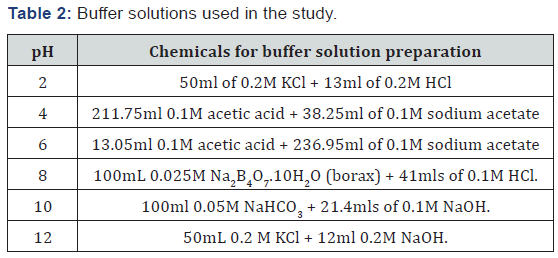
Methods
Moringa (M. Stenopetala) seed collection: Moringa seed were collected manually from the dried pods of trees. The seeds were dried in sun light for three dyes. The hull was removed from the seed surface and wings from the kernels after drying. The kernels were ground in to medium fine powder with a domestic mill to achieve solubilization of active ingredients in the seed.
Coagulant extracts: It is possible to use the Moringa seed as coagulant either as seed or extracting the oil from the seed (defatted cake). To enhance effectiveness on wastewater treatment, some studies have recommended the importance of using defatted Moringa seed[23,24]. In line with this recommendation, defatted Moringa seed was prepared for the purpose of this study.Extracts were prepared by two methods such as a simple extract with distilled water and a saline extract with sodium chloride, as explained below.
1. Simple extract
Production process of simple extract coagulant: Grinding of dry seed without shell→Aqueous dissolution of seed in distilled water→stirring→filtration To prepare 1 L of simple extract coagulant in aqueous solution, 50 g of seed powder was dissolved on 1 L of distilled water by mixing vigorously for 45 min in a magnetic stirrer at room temperature. Then, the mixture was filtered twice: once through commercial filter paper on a funnel and once again through a finefiltering system (Whatman filter paper). The result was clear, milklike liquid and was used as coagulant without further purification.
2. Saline extract
Production process of saline extract coagulant: Grinding of dry seed without shell → Dissolution of seed in a solution of 0.5M NaCl → Stirring → Filtration
To prepare 1L of saline extract coagulant in aqueous solution, 50g of powder were dissolved on 1L of NaCl 0.5M solution by mixing vigorously at pH 7 for 45min in a magnetic stirrer at room temperature. Then, the mixture was filtered twice: once through commercial filter paper on a funnel and once again through a finefiltering system (Whatman filter paper). The result was clear, milklike liquid and was used as coagulant without further purification. After, the seeds kernel dried, a domestic mill was used to grind in to fine powder to achieve solubilization of active ingredients in the seed. The extract oil was soaked in 95% ethanol, 100g of the powder in 500ml of ethanol for 45 minutes at room temperature while mixed with the help of stirrer from time to time. To obtain the defatted cake, it was required to filter the solution using filter paper. The remaining solids (pressed cakes) in the filter were then dissolved in water followed by stirring and filtration in the same way. Then the cake was allowed to dry in oven at 40 °C for 24 hours. In that process ethonal got removed from the seed cake powder. Finally, the dried seed powder is stored under room temperature until it is used for coagulation experiments (Figure 1).
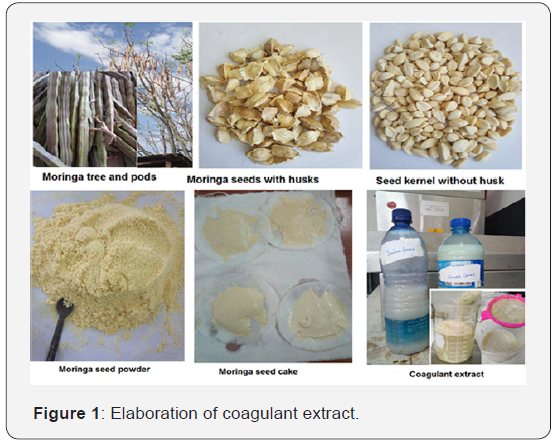
a. Yield of Moringa seed in coagulant preparation
The yield is calculated as given in equation (1).
Yield of moringa= 

Where Mi is the original weight of Moringa powder; Mf is the Final weight of Moringa powder after filtration (undissolved solids in the solution).
b. Preparation of synthetic Effluent samples
In order to test the coagulants extracts, in a first stage, synthetic samples were prepared in the laboratory using two types of dyes, all are azo type but with a classification of different class; direct and reactive dye; tested individually and as mixtures and with industrial wastewater, and mixture of dyes added to industrial waste water. The dye stock solutions were prepared by dissolving accurately weighed dyes in water to the concentration of 100-300mg/L, then dyeing with 100% cotton fabric sample following the standard procedures was carried out and dye waste water was collected after dyeing. Different concentrations were prepared from collected dye waste (250, 500, 1000ml in beakers) for treating with coagulant.
c. Effluent analysis
Total solids, dissolved solids, suspended solids, BOD5, COD were measured following standard procedure (AMHA, 1995 and Standard methods, 1995) and SPSS Statistical Data Analysis Software was used for analyzing the data.
d. Optimisation of process parameters
In order to optimize the various process parameters, coagulant dosage range of 10-80ml/L, mixing time of 30-45 minutes, pH in the range of 2-12 were used.
e. Colour Measurements
The difference in absorbance before and after treatment measured in UV-VIS spectrophotometer was used for measurements of colour removal. The results are presented as graphs with respect to various process parameters. The percentage removal efficiency of the parameters was calculated using following formula (2).
Colour Removal efficiency= 

Where Ao is the Absorbance value before treatment and A is the Absorbance value after treatment.
Results and Discussion
Yield of extracts
It has been observed that the yield of moringa seed powder dissolved in the solution is 93.4% and 92.5% for simple and saline extracts respectively. There was no significant difference between the extraction methods in terms of yield and it is evident that maximum percentage of Moringa powder is going to be consumed by the water and used wastewater treatment in the studies by dissolution.
Characteristics of Raw Textile Effluent
An initial experiment was carried out to determine the preliminary characteristics of textile effluent for examining the effectiveness of the M. stenopetala as a coagulant. The pH of the effluent was found to be in the range of pH 9 and 11.5 for all dye effluents and industrial wastewater having dyes Table 3. This indicated that the effluent/dye waste from the textile industry has more alkaline in nature. As the measurement shows, the total solids were found at maximum level of 9000ppm and 8000ppm for the two direct dyes Red 81 and Blue 86 respectively. It was decreased to 3575ppm and 3830ppm after treatment with simple extract and 3500 and 2200 in saline extract as shown in Table 4. In addition, the experiment also confirmed that the particles of TDS are higher than TSS in the textile wastewater samples. Furthermore, the experimental result of wastewater sample show COD higher than BOD5 values. This value indicates, textile wastewater contains high amount of non-biodegradables, 3 to 4 times than degradable organic matters. For instance, direct red 81 abd blue 86 have higher value of COD which is decreased to 750 and 190 respectively in simple extract. In the same way, the highest value of BOD5 was found at reactive 195 and blu 19 which was reduced to 180 and 205 respectively in simple extract. The reduction of COD and BOD5 was also observed in saline extract treatment. The treated effluent was characterized and the values of various parameters (pH, Total Dissolved Solids, turbidity, BOD5 and COD) are compared with the raw effluent. The characteristics of raw textile effluent and after treatment with simple and saline extracts are summarized in (Table 3 & 4). One liter of wastewater was used for the treatment from the total solution. All samples have been mixed for 30-45minutes. From the table, it is also clear that less removal of Turbidity, TS, COD and BOD5 for Industrial wastes and the one mixed with dye solutions waste water due to plenty of other components of wastes in industrial wastewater.


The Effects of processing parameters on Coagulation
Effect of coagulant dose
Coagulant dosage is one of the most important parameters that have been considered to determine the optimum condition for the performance of coagulants in coagulation and flocculation. The coagulant dosage indicates the concentration of M. stenopetala seed extract in the water. This difference is important to note since a lot of the seed mass was separated during the filtration step when preparing the extract. Essentially, insufficient dosage or overdosing would result in the poor performance in flocculation. Therefore, it is significant to determine the optimum dosage in order to minimize the dosing cost and sludge formation and also to obtain the optimum performance in treatment. The effect of coagulant doses (10-80ml/L) on the removal of reactive and direct dyes using Moringa stenopetala coagulant and flocculation time is 30-45min is shown in Figure 2-5. This shows that there was continuous removal of these dye colours with increasing coagulant doses up to 70ml/L as shown in (Figure 2 & 3). After 70ml/L, the colour removal decrease that confirms the optimal concentration as 70ml/L. This may be as a result of re-suspension of solids at this concentration. Furthermore, the high concentrations (>25.0mg/L) of the coagulant confer positive charges on the particle surface (a positive zeta potential), thus redispersing the particles.
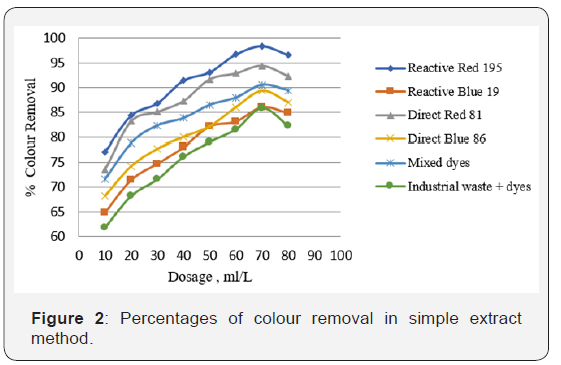
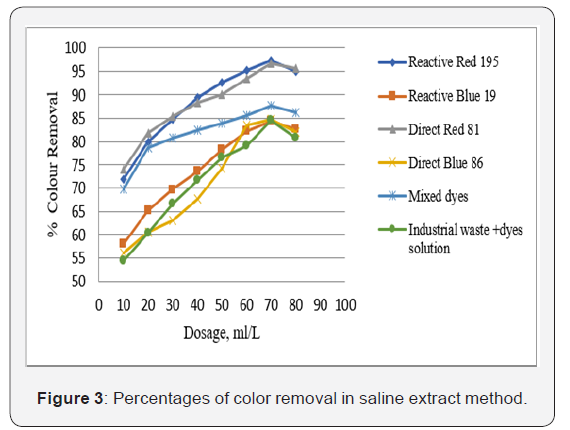

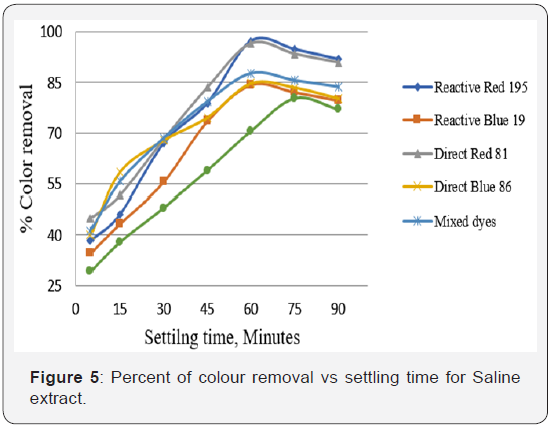
It is also an assumption that an increase in the coagulant dose may cause a decrease in pH of system. The decrease in pH may be as a result of the hydrolysis of the coagulants. Low pH values of the coagulated system usually may be attributed to the neutralization of the negatively charged surfaces of wastewater colloids, leading to their destabilization by H+ ions. However, acidification of coagulated wastewater may disturb sorption or could increase the solubility of freshly formed sludge. The highest percentage colour removal of these dyes was found to be 98.4, 86, 94.45, 89.3, 90.5 and 85.8% and 97.3, 84.45, 96.6, 84.8, 87.73 and 84.6% for Reactive red 195, Blue19, Direct Red 81, Blue 86, Industrial waste water and the mixture for both simple and saline extract respectively. This confirms that Moringa seeds to have absorbent properties and effective for removal of colour.
Colour removal
After the characterization of the effluent, the prepared coagulants from the Moringa stenopetala seeds were added to the effluent in the form of coagulant to determine the effectiveness of the extract over the textile effluent. The result shows that the extract removes the turbidity and colour from the textile effluent. Removal efficiency of up to 98.4%, for colour, was reached using 70ml Moringa Stenopetala coagulant extract. The use of Moringa seeds has an added advantage over the chemical treatment of water because it is biological and has been reported as edible [25]. All dyes selected for this study, was prepared in the laboratory for treatments and also mixed with industrial wastewater. A dye solution was prepared as required and its pH was measured by using pH meter. One liter of the initial solution was put into two beakers, and various doses of coagulant were added (10, 20, 30, 40, 50, 60, 70 and 80 in ml/L). The beakers were put one by one onto a standard magnetic stirrer. The solution was stirred for 10 min at high speed and then slowly mixed at 60rpm for 30-35min. After that, the solution was left for 45-60min for settling. The supernatant after settling was filtered through a Whatman filter paper (pore size 20–25μm). The reduction in colour concentration was measured at maximum absorbency visible wavelength of each dye solution was measured by using a UV-VIS spectrophotometer. The result of colour removal is shown in (Figure 2 & 3). In industrial wastewater colour removal is less because the effluent contains high content of dyestuff, surfactants and other additives that are generally made up of organic compounds with a complex structure. These wastewaters are collected from different sections having such different compounds and collected in wastewater plant for treatment.
Effect of flocculation time
The time of macrofloc formation (flocculation time) is one of the operating parameters that is given great consideration in any water treatment plant that involves coagulation–flocculation operations (Figure 4 & 5). Presents the effect of flocculation time using different dose of coagulants for removal of reactive dyes, direct dyes and mixture of industrial wastewater and dyes of textile effluents. The consistence increment of removals has been revealed with increasing flocculation time up to 60min, and then it decreased. The optimum flocculation time was found to be 60min. The highest removal of selected dye colours was found to be 98.4, 86, 94.45, 89.3, 90.5 and 81.5% in reactive red, reactive blue, direct red, direct blue mixed dyes and mixture of dyes/and industrial wastewater respectively in simple extract at 60 minute. As well as, for saline extract the maximum colour removal was 97.3, 84.41, 96.6, 84.8 87.73 and 80.3% in reactive red, reactive blue, direct red, direct blue, mixed dyes and mixture of dyes/and industrial wastewater respectively.
Ebeling et al studied that the removal of Turbidity and Soluble Reactive Phosphorus (SRP, orthophosphate) was increasing as settling time increased from 5 to 45min [26]. A series of jar tests were conducted to fetch the effect of settling time (0, 5, 10, 15, 20, 25 and 30min) on the removal efficiencies of BOD5, COD and TSS using low alkalinity wastewater and the results show that the small particles settle out quickly within the first 5min, with little change in the values up to 15min. The differences in BOD5, COD and TSS removal were not significant after 20min of settling as indicated by other studies [27,28]. The result of settling time is given below in (Figure 4 & 5).
Effect of mixing time
Studies were made to find out the effect of variation of the mixing time on the colour removal efficiency. Various mixing time ranging from 15 minutes to 60 minutes were maintained and the results were reported in (Figure 6 & 7). The experimental result shows that there was a continuous removal of colour, turbidity, TDS and TSS while increasing the mixing time from 15 to 45 minutes. Similar results are observed by Patel and Vashi for some other dyes [29]. When the mixing time is short (<45 minutes), the collisions between the coagulants and colloids are not efficient to precipitate suspended solids in wastewater. On the other hand, if mixing time is longer (>45 min) it would lead to an increase in flocs breakage & limit the size of the floc formed. As a result, small size flocs which are not dense to settle down & finally cause the sample to be turbid again. In sum, it is also found that the longer or shorter mixing time would result in the poor performance of the coagulant seed for binding and bridging. There were similar results in experiments made by other researchers [16]. Initially at less contact time (≤15min.) the maximum colour removal efficiency was achieved to only 63.6 and 63.7% for mixed dyes and reactive red respectively in both simple and saline extract methods respectively. But results show that when the reaction time was increased to 45 minutes, the efficiency was nearly 95% and it decreased when time increased was beyond 45minutes [30- 35].
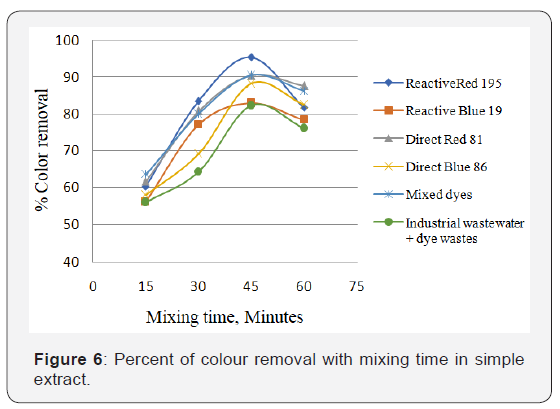
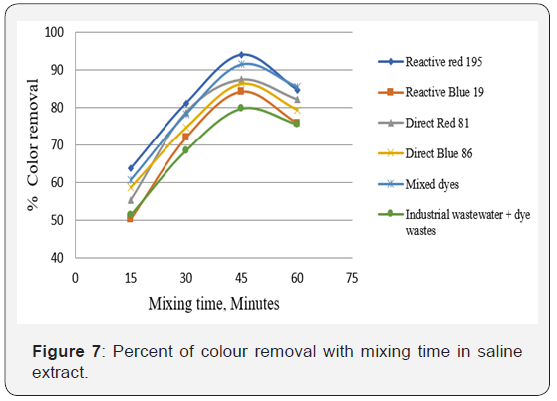
Effect of pH
The aqueous solution of dye wastes was treated by constant concentrations of dose at 70ml/L in dye wastewater of adsorbent for half a day with varying pH (2 -12). The pH was maintained with the help of buffer solutions. (Figure 8 & 9) show the effect of pH of the dye solution on the decolorization percent within the range of (2-12) for both simple and saline extract methods. The results showed that the decolorization reached maximum between pH 8-10 for both the selected dyes waste and industrial wastewater for all dosages. The effect of pH was one of the crucial parameters to determine the optimum leveling order to minimize the dosing cost and to obtain the optimum performance in treatment. pH variation in comparison had a significant effect on the decolorization of reactive dye, direct dye and mixture of them with textile wastewaters by Moringa stenopetala seed extract.
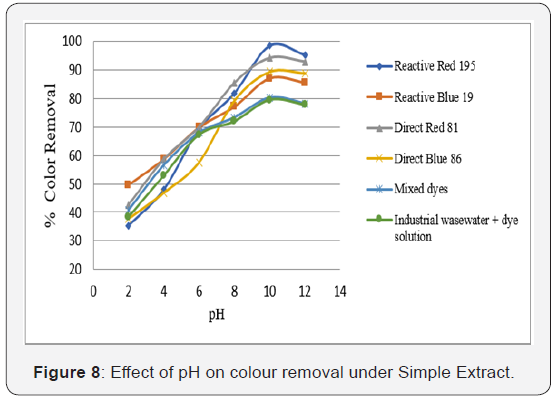
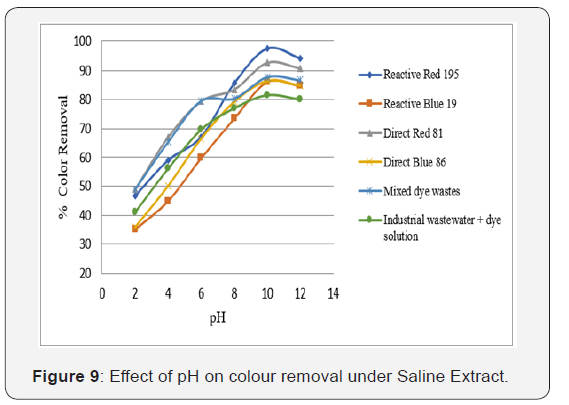
From these figures, we can understand that the highest colour removal was at pH 10 for all dye wastes. As pH increases from 2-10 the colour removal from textile wastewater increases and reach the highest point at pH 10. The removal of dyes are more at higher pH, because the surface of activated coagulants are negatively charged, the decrease in adsorption capacity at the low pH values would be expected as the acidic medium would lead to an increase in hydrogen ion concentration which would then neutralize the negatively charged coagulant surface thereby decreasing the adsorption of the positively charged ions because of reduction in the force of attraction between adsorbate and adsorbent [36-40].
Removal of Turbidity
Varying doses of the seed extract were added to the effluent followed by mixing at optimum time. The mixture was then filtered through filter paper, finally measure the turbidity value by turbidity meter. The result shows that the higher turbidity removal efficiency was obtained in simple extract method in the order of 84.6% and 83.7% in Saline extract methods for reactive blue dye (Reactive Blue 19) with the dosage of 70ml/L as shown in (Figure10 & 11).
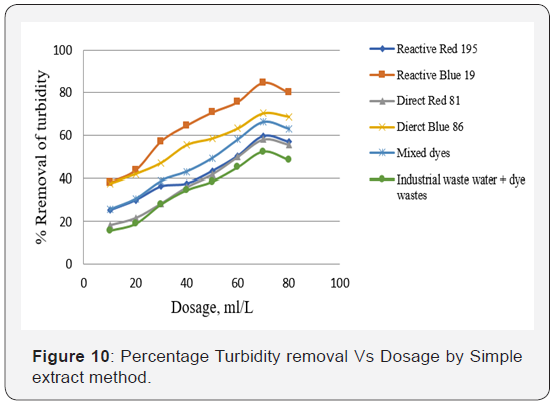

Effect of Dye types
Comparative efficiency of colour removal between reactive, direct dyes and mixture of them with industrial wastewater for both the dyes is shown as bar chart in Figure 12. The average colour removal efficiency of reactive dyes is higher than direct dyes because of the fact that the reactive dyes are a colour that can be water dissolved due to the negative charge of the sulphonate group (SO3-) and direct dyes are the molecular structure with planar positive charges that are more than the negative charges and is water soluble. Direct dyes also have sulphonate (SO3-) functionality, but in this case, it is only to improve solubility, as the negative charges on dye and fibre will repel each other. The colour shade affects the efficiency of reactive colour removal natural coagulant. On the other hand, for the mixed dye, the average colour removal is found between reactive and direct dyes, because all reactive and direct dyes are mixed together and to have interchanging of all charges which affect colour removal [41-43].

Conclusion
Seeds of Moringa stenopetala contain materials that are effective as coagulant. Coagulant dose and coagulation pH are important factors influencing the mechanism of coagulation. Depending up on the type of dye, the coagulation process varies. The optimized parameters for the coagulation of textile wastewater using M. stenopetala were pH 10 and dosage of 70ml/L that can result in removal of 98.4 and 94.45% of colour in simple extract and 97.3 and 96.6% in saline extract in both reactive and direct red dyes respectively. Moringa seed can also remove the maximum turbidity of textile dye wastes to the tune of 85%. It could be concluded that natural coagulant aid created a significant impact on the physical treatment of textile wastewater. The colour removal of mixture of industrial wastewater having reactive and direct dye solution was 85.8 and 84.6% in both simple and saline extract respectively because industrial effluent contains high content of dyestuff, surfactants and other additives that are generally made up of organic compounds with a complex structure while it is collected from different sections which use different compounds.




Comments
Post a Comment